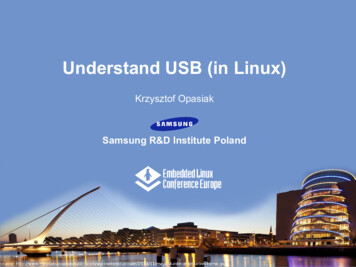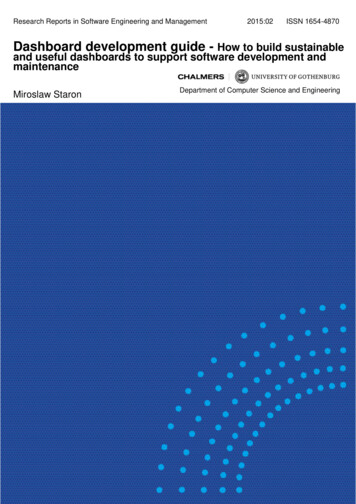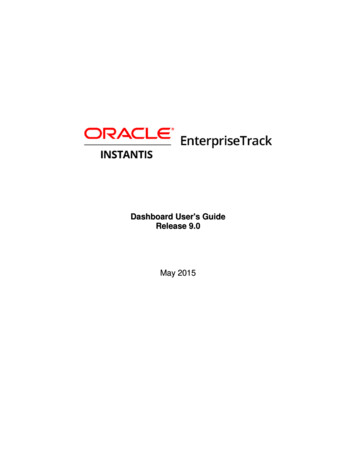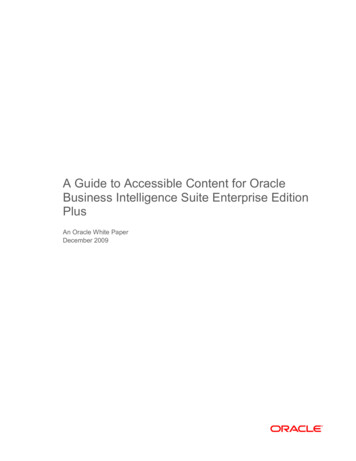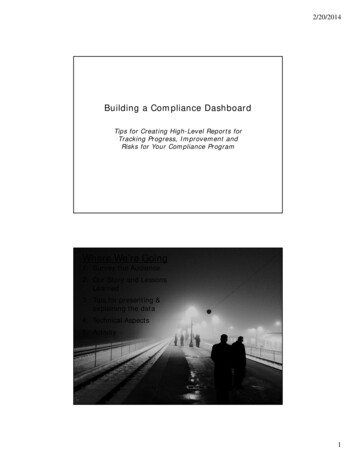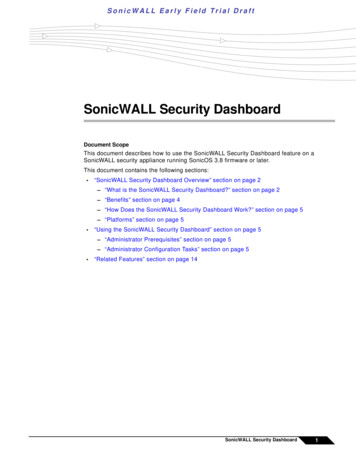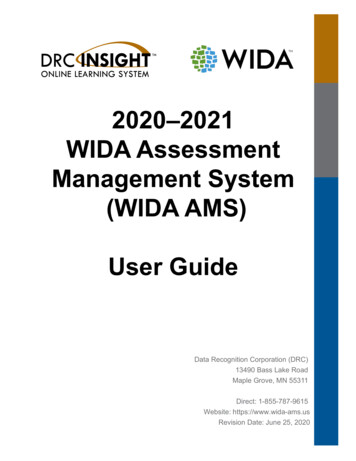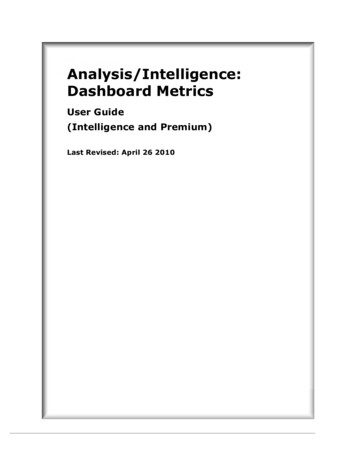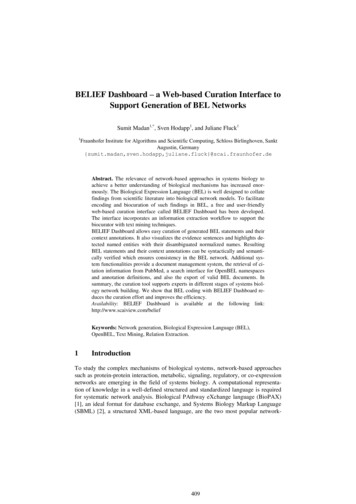
Transcription
BELIEF Dashboard – a Web-based Curation Interface toSupport Generation of BEL NetworksSumit Madan1,*, Sven Hodapp1, and Juliane Fluck11Fraunhofer Institute for Algorithms and Scientific Computing, Schloss Birlinghoven, SanktAugustin, i.fraunhofer.deAbstract. The relevance of network-based approaches in systems biology toachieve a better understanding of biological mechanisms has increased enormously. The Biological Expression Language (BEL) is well designed to collatefindings from scientific literature into biological network models. To facilitateencoding and biocuration of such findings in BEL, a free and user-friendlyweb-based curation interface called BELIEF Dashboard has been developed.The interface incorporates an information extraction workflow to support thebiocurator with text mining techniques.BELIEF Dashboard allows easy curation of generated BEL statements and theircontext annotations. It also visualizes the evidence sentences and highlights detected named entities with their disambiguated normalized names. ResultingBEL statements and their context annotations can be syntactically and semantically verified which ensures consistency in the BEL network. Additional system functionalities provide a document management system, the retrieval of citation information from PubMed, a search interface for OpenBEL namespacesand annotation definitions, and also the export of valid BEL documents. Insummary, the curation tool supports experts in different stages of systems biology network building. We show that BEL coding with BELIEF Dashboard reduces the curation effort and improves the efficiency.Availability: BELIEF Dashboard is available at the following link:http://www.scaiview.com/beliefKeywords: Network generation, Biological Expression Language (BEL),OpenBEL, Text Mining, Relation Extraction.1IntroductionTo study the complex mechanisms of biological systems, network-based approachessuch as protein-protein interaction, metabolic, signaling, regulatory, or co-expressionnetworks are emerging in the field of systems biology. A computational representation of knowledge in a well-defined structured and standardized language is requiredfor systematic network analysis. Biological PAthway eXchange language (BioPAX)[1], an ideal format for database exchange, and Systems Biology Markup Language(SBML) [2], a structured XML-based language, are the two most popular network-409
Proceedings of the Fifth BioCreative Challenge Evaluation Workshopmodeling languages in systems biology. Despite both have been used to model biochemical reaction networks, they have the drawback of being not human readable.They also have restricted possibilities to represent the various knowledge layers published in scientific literature.BEL (Biological Expression Language) is designed and engineered for systems biology experts to drive biological network-based analytics [3]. BEL conserves thebiological causal and correlative relationships gathered from scientific literature withcontextual and provenance information in a computable form. The relationships, alsoreferred to as BEL statements, are triples decomposable into a subject, a predicate,and an object (c.f. Fig. 1). An assembly of many BEL statements produces a causalnetwork knowledgebase which can be used to understand and analyze the underlyingbiological mechanisms. For example, several network models have been used to understand the cause-and-effect mechanisms of pulmonary and vascular systems [4, 5].Fig. 1. Structure of a BEL statement [6]. The example BEL statement describes that an abundance of the chemical corticosteroid reduces the biological process Oxidative Stress. For identification and disambiguation of domain specific terms and concepts several predefined BELnamespaces (e.g. CHEBI) are used.The extraction of BEL statements and thus the construction of network modelshave been done manually by experienced users through biocuration. Biocuration is aprocess to translate biological findings and information to a formal and structuredrepresentation of biological data [7]. The extraction of such findings from scientificliterature is an important and time-consuming task [7]. To handle the huge volume ofemerging and published literature and accelerate the curation, biocurators need support through automated mining systems [7]. Text mining assisted biocuration systemswhich extract current knowledge from the scientific literature, represent one of theseveral examples of such a system. In this paper, we present the BELIEF Dashboardwhich uses a text mining workflow to support knowledge extraction from literatureand allows biocuration of causal and correlative BEL statements with their contextannotations.2System Description and FunctionalitiesThe BELIEF workflow contains two main components – the text mining pipeline(BELIEF Pipeline) and the web-based curation tool (BELIEF Dashboard) (c.f. Fig. 2).Both components communicate through a HTTP/REST API.410
BELIEF Dashboard – a Curation Interface to Support Generation of BEL Networks 2.1BELIEF PipelineThe component BELIEF Pipeline includes an UIMA1-based text mining workflowwhere several state-of-the-art natural language processing (NLP), named entityrecognition (NER) and relationship extraction (RE) tools are implemented and combined to facilitate the information extraction.The dictionary- and rule-based NER software ProMiner which achieved an fmeasure of 0.8 in the BioCreative II NER assessments has been used in the workflow[8, 9]. To detect several classes of named entities (like human genes, chemicals, biological processes, diseases etc.), various dictionaries have been integrated into theworkflow. These dictionaries are used and optimized for systems biology use cases[10].For relationship classification a LibLinear-based approach [11] as well as the BioNLP-based software TEES (Turku Event Extraction System) [12] are integrated.Unlike most other approaches, the workflow converts the automatically extractedresults into full and valid BEL documents. A comparison of BioNLP-shared taskannotation with BEL and its conversion to BEL is described in Fluck et al. 2013 [13].Further details of the text-mining pipeline can be found in Fluck et al. 2014 [10].Fig. 2. Architecture of semi-automated information extraction workflow BELIEF [10]. Theworkflow consists of a text mining pipeline BELIEF Pipeline and a web-based biocuration toolBELIEF Dashboard.2.2BELIEF DashboardThe interactive web application BELIEF Dashboard supports the curation of BELstatements and context annotations which are automatically extracted by the pipeline.During the implementation of the application, we applied the concepts of userfriendliness and user-interactivity to achieve high biocuration efficiency. The webapplication framework Grails is the basis of the implementation. Grails allows aseamless integration of both Java-based frameworks UIMA and OpenBEL. TheUIMA framework is used to parse the results of the pipeline. The OpenBEL framework is used to parse and validate the BEL statements with their context annotations1http://uima.apache.org411
Proceedings of the Fifth BioCreative Challenge Evaluation Workshopagainst the various OpenBEL namespaces and annotation definitions. The applicationuses the H2 database to save the persistent data.Help Pages. The web interface offers help pages to introduce several functionalitiesof the system. As BEL is not widely used within the biomedical community, a shortintroduction page is offered to get familiar with the main concepts of BEL. Also theprocess of biocuration with the curation interface is explained in a detailed step-bystep tutorial. Various features of the user interface are described in detail as well.Project and Document Management System. A project in BELIEF Dashboard represents a curation process project which can contain several documents. The manualcuration is performed on a single document. For this purpose a document management is available which allows adding, updating and deleting any text documents.After curation a user can download or export a BELScript document containing thecuration results.Document Processing Queue. Every added text document is queued into a processing queue. As soon as the text mining pipeline BELIEF is idle again, it automatically starts retrieving the next unprocessed document from the queue and starts processing it. The document status changes to ‘processing started’. After the processinghas finished the results are pushed to the BELIEF Dashboard. When the processing issuccessfully completed the system will change the document status to ‘successfullyprocessed’. In case of processing failure the status changes to ‘processing failed’.BEL Curation Interface. The successfully processed documents are available formanual curation to the users. For this purpose the user can choose between the statement-centric or the evidence-centric curation view. The statement-centric view listsall detected statements with their evidences in tabular form. The evidence-centriccuration view (c.f. Fig. 3) visualizes the extracted BEL statements for an evidence. Toenable a better understanding of the context, sentences surrounding the evidence textare shown as well. The detected concepts found in the evidence are listed in the rightarea. The annotated text in the evidence is highlighted when the mouse is held overthe detected concepts. The concepts consist of BEL namespaces and their normalizednames detected by the NER software ProMiner. The identified BEL statements areshown in the lower area of the curation view. It allows adding, updating and deletingstatements. The context annotations such as organism, anatomy, or disease can beedited as well. The statements and context annotations are automatically validated forcorrect syntax, valid semantics, namespaces and reference citation. The errors andwarnings are provided to the user by a notification box on the lower right side of theview.412
BELIEF Dashboard – a Curation Interface to Support Generation of BEL Networks Fig. 3. Screenshot of the evidence-centric curation view. The top left side visualizes the evidence text. Detected concepts in the current evidence text are shown in the top right area. Thebottom left area allows the curation of BEL statements and their context annotations.BEL Validator. Only valid statements and context annotations can be used for thenetwork creation. Thus, it is essential that the BEL data is syntactically and semantically valid. The BEL statements and context annotations are validated as soon as theyare added or changed in the system. The input data is validated in two different ways– syntactically and semantically. If the data is invalid, a message will be triggered andvisualized to the curator.3Evaluation results3.1Text mining resultsThe performance of the text mining tool has been reported in Fluck et al. [10].ProMiner software has been used for NER which reached recall and precision valueof approximately 80% for human and mouse gene/protein name recognition in thepast BioCreative assessments [8, 9]. The evaluation of relation extraction was done onsentence level where only sentences with correctly annotated proteins were considered. The LibLinear-based classification method and TEES extracted 60% and 42%correct protein pairs respectively. An overall recall rate of 74% was achieved with thecombination of both methods. For results of the LibLinear-based method, more manual curation effort is necessary to generate complete and valid BEL statements.3.2IAT task resultsThe BioCreative V User InterActive Task (IAT) conducts a formal evaluation of thetext mining systems for a specific biocuration task. The systems are evaluated uponperformance (time-on-task and accuracy of the text mining assisted curation compared to manual curation) and a subjective measure via a user survey [14].413
Proceedings of the Fifth BioCreative Challenge Evaluation WorkshopParticipants. A total of seven curators were invited by the task organizers and wereprovided access to the BELIEF Dashboard out of which only five participated fully inthis task. In the beginning of the task a survey was conducted for the participants.Before the assignment of the tasks, the participants were first introduced to BEL andsubjected to a three-document-based training session to demonstrate the curation process and important characteristics of the system. The curators were randomly dividedinto two groups.Document corpus. A total of 20 PubMed abstracts were included in the documentcorpus. The documents were selected from different domain areas but considering thecontext for which BELIEF was created. These documents were divided into two sets(Set1 and Set2) containing 10 documents each. Table 1 describes the usage of thedocument sets by the two participant groups. Set1 was assigned to Group1 for the textmining assisted curation and to Group2 for manual curation, whereas the curationtype was transposed for the dataset Set2.Group1 (2 Users)Group2 (3 Users)Assisted curationSet1Set2Manual curationSet2Set1Table 1. Usage of the document sets by the two participant groupsAnnotation Guidelines. To guide the biocuration and create consistent high qualityannotations, well defined annotation guidelines play a crucial role. The preparedguidelines are designed to be easy to follow. The guidelines for curation with BELIEFDashboard are available on the help page.Biocuration results. In total 25 documents were curated in 392 minutes (6.53 hours)with the BELIEF Dashboard. The manual curation produced 24 documents in 374minutes (6.23 hours) out of which 8 documents (33.3 %) were invalid. These documents include several syntax errors which obstructs the BEL compilation to networks.The documents curated with the BELIEF Dashboard contained 243 BEL statementsand those with the manual curation contained 202 statements. The manually curatedinvalid documents contained 64 statements (31.68 %). Fig. 4. shows the number ofcurated documents for each annotator for both curation types. All curators producedinvalid documents but only during the manual curation.The time required by the biocurators for curation with BELIEF Dashboard and formanual curation is shown in Fig. 5. Additional effort has to be considered regardingthe several invalid documents from manual curation. The following tasks are necessary to clean up these invalid documents: (1) compile document with OpenBELFramework, (2) localize the syntax error in the BEL document, (3) fix the error, and(4) repeat until all errors are fixed. To fulfill these tasks we are assuming additional10 minutes effort for a single invalid document. The additional time has also beenadded to the average annotation time (c.f. Fig. 5. ). In comparison to manual curation414
BELIEF Dashboard – a Curation Interface to Support Generation of BEL Networks the curators used approximately 22% less time for assisted curation. This calculationalso considers additional effort which is essential to generate consistent networks.Effort to fix validation errorsManual curation (valid documents)Manual curationAssisted curation (valid documents)Number of documents12108642012345Average annotation time for onedocument (in min.)Manual curation (invalid documents)Text Mining assisted curation60504030201001CuratorFig. 4. Number of documents curated by allcurators2345CuratorFig. 5. Time usage by annotators and curationtypeSurvey results. The second survey consisted of a 10-item questionnaire. These questions are derived from the System Usability Scale2 (SUS) method which measures theperception of usability and learnability of a software product. From the 10 questions,eight measure the usability. The remaining two questions quantify the learnability.The score ranges from 0 to 100 and a score of 68 (not a percentage) is consideredaverage. BELIEF Dashboard achieved a calculated average SUS score of 66.67. Thesystem has reached an average SUS score of 67.185 and 64.58 for usability andlearnability respectively.Within the survey, the participants were also asked to comment the questions ifneeded. Some of the comments are listed below:1. Complexity of BEL: “The complexity was in the BEL language itself; the BELIEFsystem actually made it easier to start understanding how interactions were encoded.” and “The system is very easy to learn for a user who is already familiar withBEL.”2. Concept search: “More tools could be added to help the curator such as a search byterm not only by NameSpace Term. It would also be useful to know when theavailable NameSpaces that are available were updated in the case that there is amissing term one can know if it is a bug or an update issue.”3. Named entity detection: “In particular, the preselected protein identifiers were immensely useful (which I only found out when I tried to find them by hand).”4. Relation extraction: “It was cumbersome to sort through the less relevant results,but overall the system was easy to use and the disambiguation was helpful.”2http://www.measuringu.com/sus.php415
Proceedings of the Fifth BioCreative Challenge Evaluation Workshop5. BEL validator: “No way of suggesting how to correct mistakes or any correct examples.”6. Team support: “I found it really interesting to participate in this task, people wereextremely helpful and fast in answering the questions I had.”3.3ConclusionWe presented a user-friendly web-based curation interface which incorporates a semiautomatic knowledge extraction workflow to support network building for systemsbiology. It allows biocurators to extract knowledge from biomedical literature andcurate causal and correlative relationships encoded into BEL. During the IAT task thecuration interface was evaluated based on the performance and user survey. The taskhelped to identify various aspects of the interface which were helpful for the curationand revealed important issues for future improvements. We showed that BELIEFDashboard increases the curation efficiency in comparison to the manual curation.4AcknowledgementsWe acknowledge the help of Selventa Inc. supporting the integration of the OpenBELframework in our system. We thank Heinz-Theodor Mevissen to help us integratingthe ProMinerNER system into the pipeline.We are very grateful for the support of BioCreative IAT team who provided us theopportunity to take part in the IAT task and organized the whole task. Various discussions and feedback rounds helped us to create a usable curation environment for thebiocurators. We also want to thank the participants who tested our system and helpedus identifying several improvement points.Funding. We acknowledge support of our research from Philipp Morris International.Conflict of Interest. None declared.5References1.Demir E, Cary MP, Paley S, et al. (2010) The BioPAX community standard forpathway data sharing. Nat Biotechnol 28:935–942. doi: 10.1038/nbt.16662.Finney a M, Hucka M, Sauro HM, et al. (2001) The Systems Biology MarkupLanguage. Mol Biol Cell 12:708.3.Slater T (2014) Recent advances in modeling languages for pathway maps andcomputable biological networks. Drug Discov Today 19:193–198.4.Schlage WK, Westra JW, Gebel S, et al. (2011) A computable cellular stress networkmodel for non-diseased pulmonary and cardiovascular tissue. BMC Syst Biol 5:168.doi: 10.1186/1752-0509-5-1685.Boué S, Talikka M, Westra JW, et al. (2015) Causal biological network database: acomprehensive platform of causal biological network models focused on the416
BELIEF Dashboard – a Curation Interface to Support Generation of BEL Networks pulmonary and vascular systems. Database (Oxford) 2015:bav030–. doi:10.1093/database/bav0306.Fluck J (2015) BELIEF – A semiautomatic workflow for BEL network creation. In:Conf. From Big Data to Smart Knowl. – Text Data Min. Sci. ult/files/textmining/Fluck Talk.pdf.7.Howe D, Costanzo M, Fey P, et al. (2008) Big data: The future of biocuration. Nature455:47–50. doi: 10.1038/455047a8.Hanisch D, Fundel K, Mevissen H-T, et al. (2005) ProMiner: rule-based protein andgene entity recognition. BMC Bioinformatics 6 Suppl 1:S14.9.Fluck J, Mevissen H-T, Dach H, et al. (2007) ProMiner: Recognition of Human Geneand Protein Names using regularly updated Dictionaries. In: Hirschmann L, KrallingerM, Valencia A (eds) Proc. Second BioCreative Chall. Eval. Work. pp 149–15110.Fluck J, Madan S, Ansari S, et al. (2014) BELIEF - A semiautomatic workflow forBEL network creation. In: Proc. 6th Int. Symp. Semant. Min. Biomed. pp 109–11311.Bobic T, Klinger R, Thomas P, et Al. (2012) Improving Distantly SupervisedExtraction of Drug-Drug and Protein-Protein Interactions. In: Proc. ROBUS-UNSUP2012 Jt. Work. Unsupervised Semi-Supervised Learn. NLP. pp 35–4312.Björne J, Salakoski T (2013) TEES 2.1: Automated annotation scheme learning in theBioNLP 2013 Shared Task. In: Proc. BioNLP Shar. Task 2013 Work. Association forComputational Linguistics, pp 16–2513.Fluck J, Klenner A, Madan S, et al. (2013) BEL networks derived from qualitativetranslations of BioNLP Shared Task annotations. In: Proc. BioNLP Shar. Task 2013Work. Association for Computational Linguistics (ACL), pp 80–8814.Arighi C (2015) BioCreative V - User Interactive Task -v/track-5-IAT/. Accessed 21 Aug 2015417
BELIEF Dashboard - a Web-based . The relevance of network-based approaches in systems biology to achieve a better understanding of biological mechanisms has increased enor-mously. The Biological Expression Language (BEL) is well designed to collate findings from scientific literature into biological network models. To facilitate


